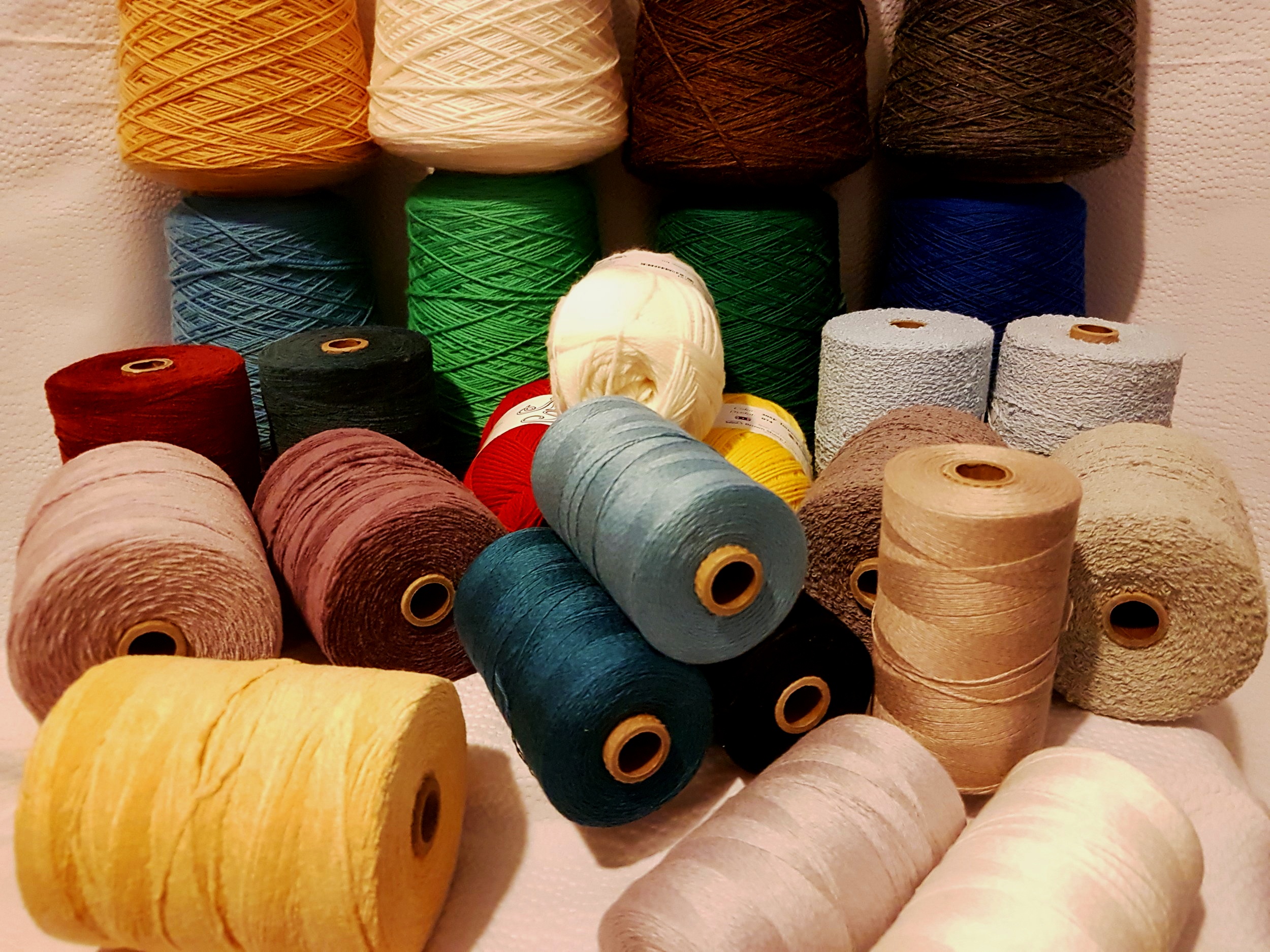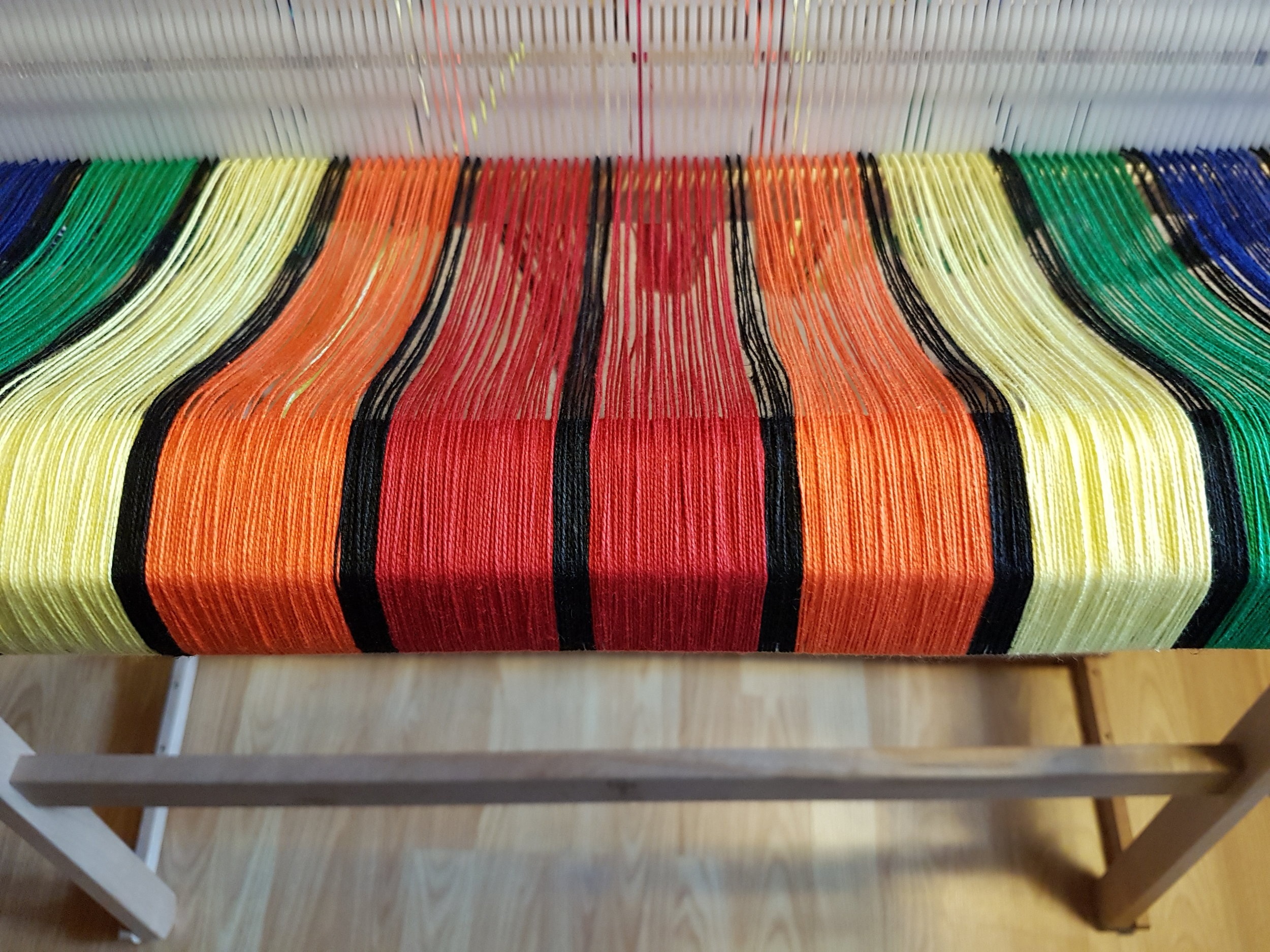How to Nurture a Relationship that Lasts (with your Rigid Heddle) PT 2
Last week we discussed choosing the right loom. This week is about providing your loom with what it needs to thrive. It might be your loom’s responsibility to please you, but it is your responsibility to provide it, and you, with the proper tools and equipment. A new loom package will give you everything you need, except the yarn, to get started with basic weaving.
Care and Feeding
Last week we discussed choosing the right loom. This week is about providing your loom with what it needs to thrive. It might be your loom’s responsibility to please you, but it is your responsibility to provide it, and you, with the proper tools and equipment. A new loom package will give you everything you need, except the yarn, to get started with basic weaving. You will get a loom, a reed (some let you choose the size, most give a 7.5 or 8 dent reed) 2 shuttles, clamps, warping peg and a threading hook.
It can be tempting when starting new hobby to minimize expenses. After all, you may not like it. But I guarantee you won’t like it if you don’t have the right equipment! Trying to weave on a 32” loom without a stand will cause you physical pain and you’ll start to associate weaving with pain. Not getting the size reed to use the yarn you really want to use will leave you feeling dissatisfied with your finished products. And using poor quality fibres can create so many problems that you dread going to your loom. Skimping can sabotage a potentially beautiful relationship. Besides, for most of us it is psychologically less painful to drop $600 in one fell swoop and have everything we want/need than to be continually spending $100-150 while still feeling there is more we need to be really content.
What else should you get?
32” with stand
1. A stand is a must if you are getting a loom bigger than 24”. If you are getting less than 24” I still recommend a stand because it makes warping so much easier. If you or someone you know is handy go ahead and build your own…but remember that the designers of the stand for your loom have had lots of experience and know what height and angle is best and how to balance it so it isn’t prone to tipping!
2. Extra reeds. Think about the yarns you want to use and the projects you want to weave and get the right reeds. The 7.5 or 8 dent reeds that many looms come with are great for dk and worsted weight yarns. 10 dent for sport and fingering, 4/8 cotton, or 2/8 cotton doubled; 12.5 for fingering; and 15 for lace. At the other end, a 5 dent is good for aran/bulky and a 2.5 for super bulky. You might also consider getting 2 of the same size so you can learn double weave to either weave wider blankets, get the sett you want (2 10 dent reeds allow you to weave at 20 ends per inch) or weave twill.
3. Extra shuttles of various sizes. Just because you have a 32” loom does not mean all your shuttles should be 32”. The shuttles should be just a little longer than your project is wide. It’s just more comfortable. Using a 32” shuttle takes a lot of shoulder energy and can be tiring so if you are working on a 12” scarf, using a 14” shuttle is much more comfortable.
Pick Up Stick and Shuttle
4. Pick Up sticks…these are like shuttles except with points on the end. They make it very easy to create complex looking patterns.
5. A couple good books and classes. I’m a fan of in person classes over online classes simply because a live instructor can personalize to you specifically. S/he can see what you are doing and give tips specific to you. Plus you will learn from the others in the class and perhaps meet new, local, friends! That being said, online classes do have benefits…you can do them at your convenience, repeat as many times as you want and have very experienced teachers.
6. Good quality fibres that you love! Life is too short to use ugly yarn. This is your hobby and you should enjoy every moment spent at your loom. Don’t sabotage a potentially beautiful relationship by using poor quality yarn because it’s cheap. Get the best you can afford, something that feels nice in your hands and gives you pleasure just to look at. Even for beginner projects, maybe especially for beginner projects! Your first projects may not be perfect but if you hate the yarn, can’t stand the feel if it or it's a mess on the loom you will begin to associate weaving with negative emotions. First impressions are important!
Fun and Handy Extras
There are always a few things that you don’t really need, but they definitely add to the ease and enjoyment of weaving.
Varident Reed
1. Varident reed: this is pretty cool. It’s a reed with pieces of reeds of all sizes that you can put together in the order you want to use any weight yarn in one project. Great for using up all those little bits of leftover yarn.
Fringe Twister
2. Fringe twister: another very cool gadget. Just clip, turn and tie and you have a beautiful twisted fringe. Untwisted fringes tend to look a little tattered over time.
3. Extra warping sticks: if you plan to weave lots of yardage, these will come in very handy.
4. A portable light that will clamp onto your loom. It’s always nice to have good light!
Just a quick note about buying used looms. This is a great way to get a fantastic deal. Before you buy, make sure all the pieces are there, that the loom holds tension and that you can get parts if you need them (extra reeds, double heddle kit if it isn’t built in, stand if you want one etc). It’s not a deal if you can’t use it.
I hope if you are considering a loom, or are a beginner weaver, you have found this helpful. If you are not a weaver, and you’ve read this far…wow! Thanks! Here’s my words of wisdom for the week: Life is always easier with the right tools (whether it’s a skill to learn or a physical object). It’s worth learning what they are and acquiring them. So many times we “make do” and struggle, but if we used the right tool (or skill) the job would have been done faster and better, with less grief, and we might have enjoyed it! I don’t believe we need to buy everything, on the contrary I believe we should buy less. Borrow when you can, share what you have. But when you do buy, buy the right tool. You will enjoy life more!
What Yarn Should I Use?
Asking what yarn you should use is a bit like asking what you should eat. There are no right and wrong answers, it all depends on what you are trying to achieve. Even as I have started to write this, I’ve realized there are just too many answers for one blog. Today then, we will talk about what you want to make and I’ll give some of my favourites. This post will give you some guidelines to consider but will not pretend to know everything, or even very much!
Asking what yarn you should use is a bit like asking what you should eat. There are no right and wrong answers, it all depends on what you are trying to achieve. Even as I have started to write this, I’ve realized there are just too many answers for one blog. Today then, we will talk about what you want to make and I’ll give some of my favourites. This post will give you some guidelines to consider but will not pretend to know everything, or even very much!
A small sample I wove before making a shirt
What do you want to make? This is a key question. A light summer wrap will use very different fibres than something intended to withstand the winter winds! A floor rug needs to be tough and heavy (or be backed with something to stop it from slipping everywhere) but also easy to care for. Tea towels need to be absorbent and washable. Placemats need to be heavy enough to stay put. A shirt needs to have a nice drape but not be see though, but a sweat shirt or hoodie is ok with less drape.
This is where sampling can save you! Take the time to weave and finish a 12” piece. Measure it before and after finishing so you know what the shrinkage is. Handle it. If it’s going to be sewn try sewing a little bit of it. It’s better to know now that the sett needs to be higher or lower or that it feels awful than after you’ve woven 3 meters!
A summer shawl is meant to be light. Just enough to protect from a light breeze or maybe protect your shoulders from the sun. My summer shawl favourites are fingering or lace weights, silk, silk blends, linen, and tencel. Pairing the fingering warp with a lace weight weft is also lovely and a great way to let a special hand dyed warp really shine. Using a sticky yarn (mohair for example) allows you to use a wider sett creating a very airy fabric.
Waffle Weave
Alpaca or wool in a worsted weight make a fabulously warm and quick weave for winter. Using a thick and thin yarn adds a lovely texture without any extra work. Or a simple waffle weave gives a really cushy feel. Long repeats in warp and weft can give a plaid effect without you ever needing to change colour! Since alpaca is so warm, fingering weight is also a good choice for fall and winter. A woven blanket can also double as a cozy wrap.
Unmercerized cotton, cotolin and linen and hemp are great in the kitchen. Tea towels, dish clothes, placemats, or floor rugs. They are all washable and hard wearing…meant to be used! (do not use fabric softeners when washing towels, they will become less absorbent) On my rigid heddle I like to use my 10 dent reed and 2/8 cotton or cotolin doubled for tea towels. For placemats I use a 7.5 heddle and 4/8 cotton doubled. For a rug try warping with 4/8 cotton and using old sheets or t-shirts or jeans for the weft.
Bamboo and Tencel
Weaving for clothing a whole topic on it’s own. But as a general rule, think about drape and thickness. The fabric will be cut and sewn…always finish your fabric before cutting! Think about the thickness of seams. Everything I’ve woven has been much heavier than any store bought fabric. You’ll want to find patterns to suit your fabric and think about the best way to finish the seams with the least bulk. Investing in a walking foot and an overlock foot will make sewing much easier.

















